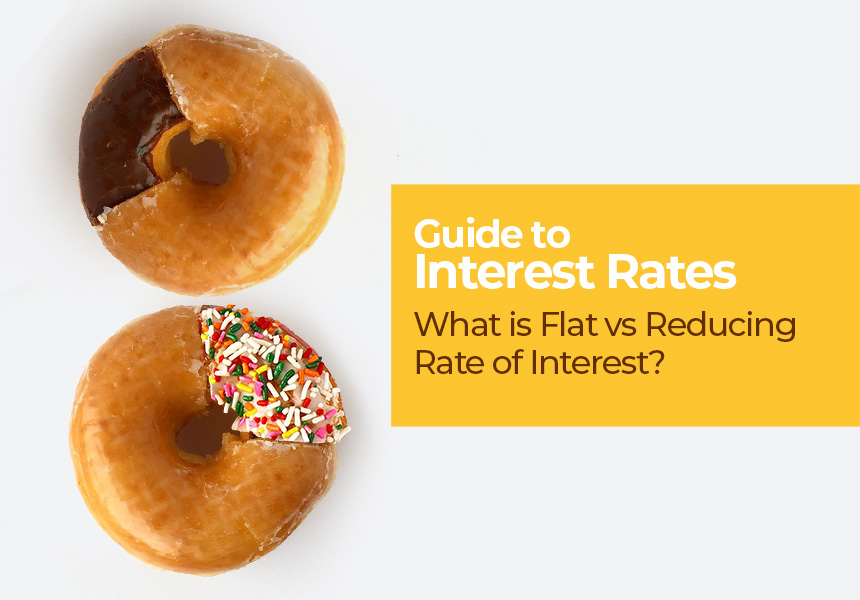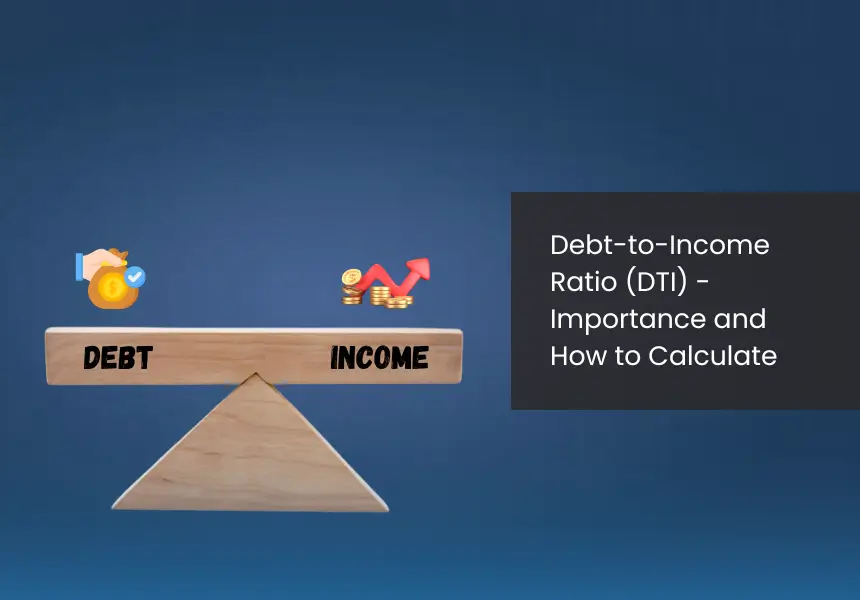
The seemingly drab world of financials can be interesting if you look closely! In today’s context, when each one of us looks up to have a lifestyle that is plush with comfort & adventure, experience & experimentation, we need to be financially aware and vigilant. This includes having information about the various types of financial tools and aids, such as loans, available at varying rates of interest.
Each one of us has availed (or will avail, in the future) loans to fund their dreams of a bigger home, a better lifestyle, a car, an expensive all-featured bike, or a much dreamed of international holiday, or even to pay off a large credit card bill. All these loans come with interest rates; these interest rates depend on the lender, loan amount, and your credit ranking. It is not only interesting but essential to understand the different ways in which interest rates are applied & how they are calculated.
What is meant by Interest Rate?
Here’s a quick lesson on what is meant by Interest Rate. Basically, you borrow a sum of money to fuel your dream from a bank or another money-lending institute. This bank or institute gives you the loan and for this facility, they charge an additional amount from you which is over and above the amount they have lent you. The amount you have availed as “loan” is the “principal” amount and the additional money you pay for availing the loan is called the “interest”.
Now, this interest can be charged on an annual, quarterly, or monthly basis, depending on the lender and the terms of the loan that you have agreed upon. The “rate of interest” refers to the percentage of the “principal” that is charged as the “interest”. There are several types of “rates of interest” that different loans entail.
What are Flat Rate or Fixed Rate Loans?
In Flat/Fixed Rate Loan, the interest amount is calculated on the full amount of the loan (the principal). This interest amount remains the same for the entire tenure of the loan (that is, for the entire duration for which you have borrowed the money).
This type of interest is typically applied for short-term & traditional personal loans. Since the interest amount remains the same during the entire tenure of the loan, this type of loan would turn out to be more expensive than a reducing rate of interest loan.
Let’s understand this with an example:
Pritha takes a personal loan of INR 1,00,000/- at a flat interest rate of annual 18% for 2 years.
Here is the breakdown of interest and EMI:
Total Interest Rate: ₹1,00,000 (Principal) X 18% (Rate of Interest) X Tenure = 18,000 X 2 = 36,000
Monthly EMI = ₹1,00,000 (Principal) + ₹36,000 (Interest) / Tenure = ₹1,36,000 / 24 Months = ₹5,666.66
And Pritha ends up paying ₹1,36,000 as the final repayment toward the loan.
What is Reducing or Diminishing Rate of Interest?
With a reducing rate loan, when you pay your EMI, a part of this payment goes toward the interest payment for that month and the remaining goes toward the payment of the principal amount. So, in the subsequent month, the principal amount is reduced, and the interest amount is also lowered since it is calculated on that reduced principal amount. We have illustrated the reducing nature of interest in subsequent sections of the article.
When looking for personal loans, you must make a fair comparison to understand which type of interest is levied on the loan. Since reducing rate of interest lowers your Principal amount every month, it is better for your pocket in the long run.
If the same interest rate is charged in both flat and reducing loans, you would end up paying higher interest amount in case of flat as compared to a reducing rate of interest. This is illustrated in the example below.
Comparison of Reducing Vs Flat Rate of Interest
Let us compare Reducing Interest Rate vs Flat Interest Rate with the following example –
| Flat Rate | Reducing Rate | |
| Loan Amount | ₹1,00,000 | |
| Tenure | 12 Months | |
| Interest | 18% | |
| EMI | ₹9,834 | ₹9,168 |
| Total Interest | ₹18,000 | ₹10,016 |
Let us look at a clear comparison in a tabulated form:
Example of Reducing Rate of Interest
| Month | Opening Principal | EMI | Interest Component | Principal Component | Principal Outstanding |
| 1 | 1,00,000.00 | 9,168 | 1,500.00 | 7,668.00 | 92,332.00 |
| 2 | 92,332.00 | 9,168 | 1,384.98 | 7,783.02 | 84,548.98 |
| 3 | 84,548.98 | 9,168 | 1,268.23 | 7,899.76 | 76,649.22 |
| 4 | 76,649.22 | 9,168 | 1,149.74 | 8,018.26 | 68,630.96 |
| 5 | 68,630.96 | 9,168 | 1,029.46 | 8,138.53 | 60,492.42 |
| 6 | 60,492.42 | 9,168 | 907.39 | 8,260.61 | 52,231.81 |
| 7 | 52,231.81 | 9,168 | 783.48 | 8,384.52 | 43,847.29 |
| 8 | 43,847.29 | 9,168 | 657.71 | 8,510.29 | 35,337.00 |
| 9 | 35,337.00 | 9,168 | 530.05 | 8,637.94 | 26,699.05 |
| 10 | 26,699.05 | 9,168 | 400.49 | 8,767.51 | 17,931.54 |
| 11 | 17,931.54 | 9,168 | 268.97 | 8,899.03 | 9,032.51 |
| 12 | 9,032.51 | 9,168 | 135.49 | 9,032.51 | – |
Example of Flat Rate of Interest
| Month | Opening Principal | EMI | Interest Component | Principal Component | Principal Outstanding |
| 1 | 1,00,000 | 9,833 | 1,500 | 8,333 | 91,667 |
| 2 | 91,667 | 9,833 | 1,500 | 8,333 | 83,333 |
| 3 | 83,333 | 9,833 | 1,500 | 8,333 | 75,000 |
| 4 | 75,000 | 9,833 | 1,500 | 8,333 | 66,667 |
| 5 | 66,667 | 9,833 | 1,500 | 8,333 | 58,333 |
| 6 | 58,333 | 9,833 | 1,500 | 8,333 | 50,000 |
| 7 | 50,000 | 9,833 | 1,500 | 8,333 | 41,667 |
| 8 | 41,667 | 9,833 | 1,500 | 8,333 | 33,333 |
| 9 | 33,333 | 9,833 | 1,500 | 8,333 | 25,000 |
| 10 | 25,000 | 9,833 | 1,500 | 8,333 | 16,667 |
| 11 | 16,667 | 9,833 | 1,500 | 8,333 | 8,333 |
| 12 | 8,333 | 9,833 | 1,500 | 8,333 | – |
What is Floating Rate of Interest?
This type of rate of interest is commonly used for home loans. It is also known as “variable rate of interest” owing to the nature of its calculation. Completely opposite to the fixed interest rate, the floating interest rate changes (probably multiple times) during the loan tenure. This change depends on several factors, including the Reserve Bank of India’s policies, revised lending rates, and other reference data points.
The Floating Interest Rates are typically applied on long term loans like home loans, business loans, and mortgage payments among others. The caveat in floating interest rates is that it may rise or fall depending on economic changes and monetary policies, so the borrower needs to be up & ready for a dynamic change in the situation. The good part of these loans is of course that the rate of interest may fall, so you pay as per the latest rates (lower). Needless to mention, in case the rates rise, the payable interest increases as well.
Read our blog on- Decoding Loan Jargons-Personal Loan Glossary
What are Bullet Loans and How do they work?
When we speak about long term loans or larger ticket (amount) loans in the personal loans space, it is important to update ourselves with the concept of Bullet Loans as well. Popularly known as EMI-Free Loans, bullet loans are what they sound like! Like a bullet, a large lump sum (i.e. principal amount) is to be paid by the borrower at the end of the loan tenure or at regular intervals (like 6 months) which is pre-decided.
EMI-Free loans like the name suggests do not involve EMI, i.e. Principal + Interest. Only interest amount is paid every month, which is significantly lower than regular EMI. Bullet payments are to be made at regular intervals or at the end of the loan tenure depending on the payment structure.
It is a new kind of loan type and extremely popular since it offloads the burden of EMIs. The borrower is able to reduce his / her monthly loan outflow by as much as 40% as compared to a traditional personal loan! It is a flexible personal loan, basically, with the option to pay only monthly interest and bullet payments of lumpsum portions of the principal amount.
Example of a Bullet Loan : How do Bullet Loans (EMI-Free Loan) Work?
For instance, Disha takes a loan of INR 1,00,000 as an EMI-free loan for a period of 12 months at the rate of interest of 18% per annum in January 2019. She has to only pay the monthly interest INR 1500 from January to June 2019 along with 2 bullet payments every 6 months. In June 2019, she has to make a bullet payment of INR 50,000 + interest amount. This further reduces her interest payment as it reduces the principal outstanding.
| Month | Opening Principal |
Monthly Payment Interest + Bullet Payments |
Principal Outstanding | |
| 1 | 1,00,000.00 | 1,500.00 | 1,00,000.00 | |
| 2 | 1,00,000.00 | 1,500.00 | 1,00,000.00 | |
| 3 | 1,00,000.00 | 1,500.00 | 1,00,000.00 | |
| 4 | 1,00,000.00 | 1,500.00 | 1,00,000.00 | |
| 5 | 1,00,000.00 | 1,500.00 | 1,00,000.00 | |
| 6 | 1,00,000.00 | 1,500.00 | 50,000.00 | 50,000.00 |
| 7 | 50,000.00 | 750.00 | 50,000.00 | |
| 8 | 50,000.00 | 750.00 | 50,000.00 | |
| 9 | 50,000.00 | 750.00 | 50,000.00 | |
| 10 | 50,000.00 | 750.00 | 50,000.00 | |
| 11 | 50,000.00 | 750.00 | 50,000.00 | |
| 12 | 50,000.00 | 750.00 | 50,000.00 | – |
With multitude of loans being available in the market, with different interest rates tagged to each loan, you, the borrower, must be well informed on what agreement you make with your loan provider. The interest rates are based on the amounts being borrowed, the duration of loan, whether collaterals are pledged against the loan or not, reason for the loan, credit-worthiness of the borrower and so on.
It is imperative to make a decision based on the variables relevant for you since no one rate of interest is a clear winner (or a loser, for that matter)!
At LoanTap, we offers EMI Free Loan between Rs 1 Lakh to Rs 10 Lakh, for tenures between 6 months to 5 years. With EMI Free Loan from LoanTap, you pay only interest every month and make partial bullet payments towards principal outstanding amount every 6 months.
Download our Personal Loan App to Apply For an Instant Loan: Google Playstore / Apple App Store








